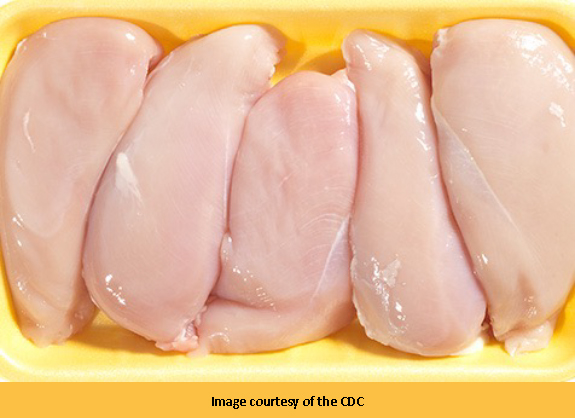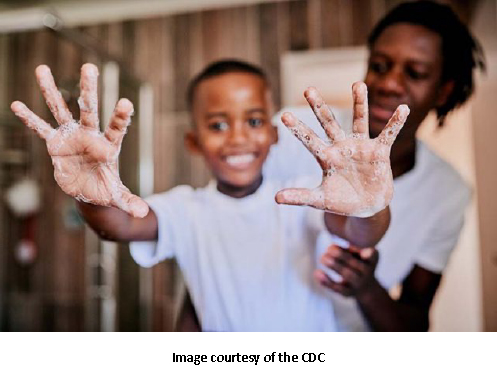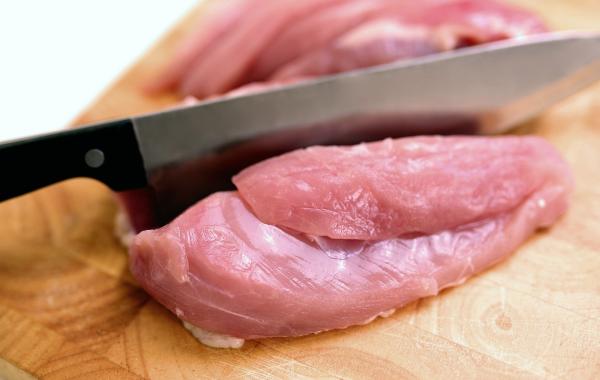Three hundred consumers participated in a study to test the effectiveness of educational interventions on poultry washing before cooking. All participants were self-reported “poultry washers.” The “treatment group” received education in emails containing videos and infographics advising against the practice of poultry washing. The control group received no educational materials.
 All participants were observed cooking chicken thighs that had been inoculated with a non-pathogenic but traceable E. coli bacterial strain. They also prepared a salad. The purpose of the study was to determine the extent of cross-contamination between the inoculated chicken, the salad, sink, and other food contact surfaces in the kitchen.
All participants were observed cooking chicken thighs that had been inoculated with a non-pathogenic but traceable E. coli bacterial strain. They also prepared a salad. The purpose of the study was to determine the extent of cross-contamination between the inoculated chicken, the salad, sink, and other food contact surfaces in the kitchen.
The educational portion of the study was promising: Ninety-three percent of the treatment groups did not wash the chicken thighs before cooking, compared with 39% of the control group.
The bigger surprise was the extent of cross-contamination, not only with chicken washers but also with the non-washers. High levels of E. coli were detected in the sink and on the salad, suggesting that the bacteria were transferred from the chicken, it's packaging, and/or contaminated hands. Splashing of ‘chicken juice’ during carcass washing was not the primary culprit as hypothesized. Here is the breakdown of contamination:
- Among those washing the chicken “to rinse off” bacteria, 26% of those in the control group and 30% in the educated group contaminated the salad by not washing their hands after handling the chicken.
- For those not rinsing the chicken, 31% of the control group and 15% of the educated group contaminated their salads.
Whether washed or not, chicken preparation resulted in contamination of the salad, which is alarming because lettuce and other salad ingredient are not cooked before eating. While pathogens on the chicken thighs would be destroyed in the oven if heated sufficiently, family members could become infected with diarrhea-causing pathogens from eating cross-contaminated, raw produce.
 The suspected cross-contamination culprit in this study were hands, like yours and mine. Unfortunately, since the study was focused on sinks and washing, the participant’s hands were not swabbed and assayed for the inoculated bacteria. That data would have been helpful. Despite this study's short-coming, the researchers suggested a more complex message, reframing the food safety message from “don’t wash poultry” to “wash your hands and sanitize sinks and surfaces.” Let’s review some essential recommendations from the USDA and CDC:
The suspected cross-contamination culprit in this study were hands, like yours and mine. Unfortunately, since the study was focused on sinks and washing, the participant’s hands were not swabbed and assayed for the inoculated bacteria. That data would have been helpful. Despite this study's short-coming, the researchers suggested a more complex message, reframing the food safety message from “don’t wash poultry” to “wash your hands and sanitize sinks and surfaces.” Let’s review some essential recommendations from the USDA and CDC:
- Prepare foods that will not be cooked, such as vegetables and salads, BEFORE handling and preparing raw meat and poultry.
- Thoroughly clean and sanitize ANY surface that has potentially touched or been contaminated from raw meat and poultry, or their juices, with hot soapy water, and then apply a sanitizer.
- Do not wash raw poultry. Use a separate cutting board for all raw meats.
- Wash your hands immediately after handling raw meat and poultry. Wet your hands with water, lather with soap, and then scrub your hands for 20 seconds. Does singing “Happy Birthday” ring any bells for the time to spend washing your hands?
- Never place cooked food or fresh produce on a plate, cutting board, or other surfaces that previously held raw chicken.
As Julia Child would say, “Bon Appetit!”
Source: Julia Child Was Wrong: Don't Wash Your Raw Chicken, Folks Morning Edition, NPR




